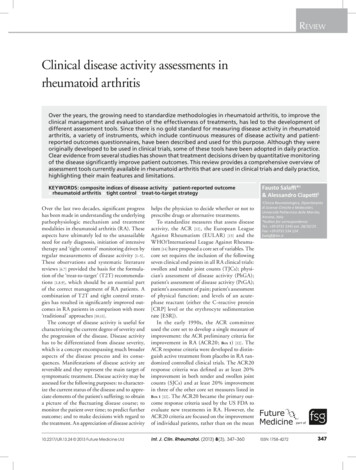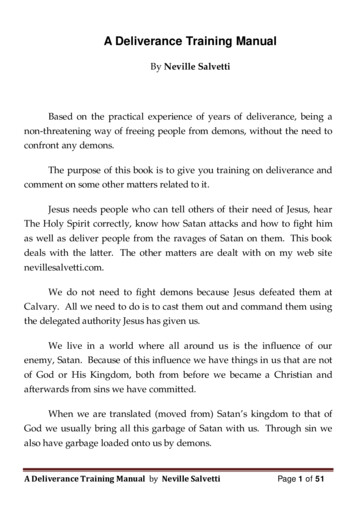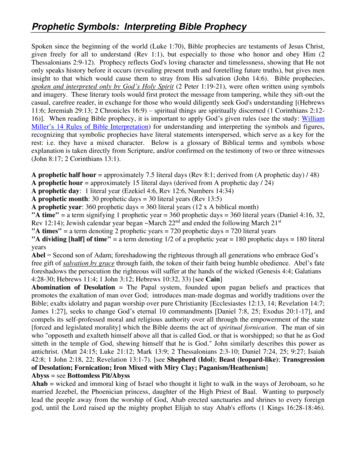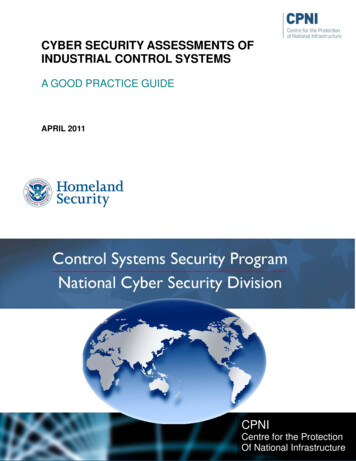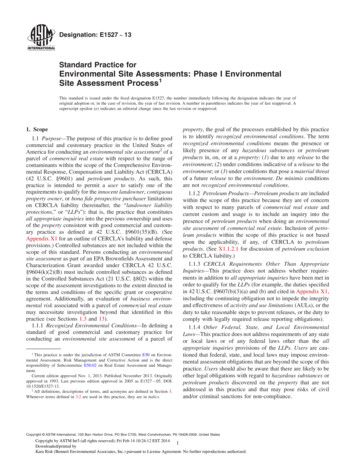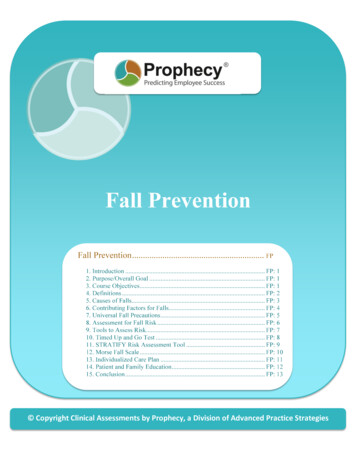
Transcription
Copyright Clinical Assessments by Prophecy, a Division of Advanced Practice Strategies
FP: 1Fall PreventionINTRODUCTIONPreventing patient falls is vital. Falls can lengthen hospital stays and result in poor quality of life,increased costs, admission to a long-term care facility, serious physical injuries, and even death.Falls are the most common adverse events reported in U.S. hospitals. As many as 15% of hospitalizedpatients fall at least once during their hospital stay, and inpatient falls lead to injury in up to 33% ofcases.Fall prevention requires cooperation and coordination among caregivers. While some aspects of fallprevention care can be standardized, others must be tailored to each patient's specific risks. Good fallprevention requires teamwork, operational practices that promote good communication, and individualexpertise.PURPOSE/OVERALL GOALThis module outlines measures that providers can take to help prevent patient falls. It provides anoverview of causes, contributing factors, precautions to take, ways to assess fall risk, and how to involvepatients and families in fall prevention strategies.The goal of this module is to eliminate – or at least greatly reduce – the instances of patient falls and themorbidity and mortality associated with them.COURSE OBJECTIVESAfter completing this module, the learner should be able to:1. Define the main categories of patient falls2. Describe factors that contribute to fall risk3. Define universal fall precautions4. Demonstrate how to assess fall risk in patients5. Describe the importance of educating patients and families about fall prevention
FP: 2DEFINITIONSA patient fall is any unplanned descent to a lower plane with or without injury to the patient. The presence or absence of injury is not a factor in the definition of a fall. The distance to the next lower surface is also not a factor in determining whether a fall hasoccurred. All types of falls should be reported so that steps can be taken to avoid them in the future.There are four main categories of falls: observed, assisted, unobserved, and near falls.1. Observed FallAn observed fall occurs: When a staff member sees a patient experience a loss of balance and land on the floor or onanother object such as a bed, chair, or wheelchair When a patient comes to rest on the ground (or lower plane) without intending to do so2. Assisted FallAn assisted fall occurs: When a staff member or a non-staff member lowers the patient to the floor (or lower plane) When a patient lowers himself or herself to the floor (or lower plane) because of feeling dizzy orweak3. Unobserved FallAn unobserved fall is often referred to as being “found down” or “found on the floor” and occurs: When a patient is found on the floor and neither the patient nor anyone else knows how he orshe came to be on the floor When a patient reports that he or she has fallen; unless proven otherwise, this is considered afall4. Near FallA near fall occurs when a patient experiences an unexpected sudden loss of balance that does not resultin a fall or other injury. For example, a patient may slip, stumble, or trip but is able to regain balance control, therebyavoiding a fall to a lower plane. Episodes where the patient loses his or her balance and would have fallen were it not for staffintervention is a near fall. Intercepted falls are near falls.
FP: 3CAUSES OF FALLSUnderstanding the causes of falls is a critical component in preventing them. Inpatient falls can occurbecause of: Physiologic factors Unexpected events Environmental factors Other factorsPhysiologic FactorsMost in-hospital falls belong to this category. Physiologic causes include: Patient confusion Frequent toileting needs Cardiac conditions such as arrhythmias Neurologic conditions such as Parkinson’s disease or dementia Musculoskeletal factors such as arthritis, abnormal gait, or deconditioning Vascular conditions such as hypotension Visual impairment Metabolic abnormalities such as hypoglycemia or hypothyroidism Psychiatric conditions such as depressionUnanticipated EventsUnanticipated events include: New-onset syncope Seizure StrokeEnvironmental FactorsEnvironmental factors include: Inadequate lighting Poorly-fitting shoes Loose carpet Slippery floors Lack of handrails Uneven stairsOther Factors Medications that are thought to increase fall risk include benzodiazepines, sleep aids,neuroleptics, antidepressants, anticonvulsants, antipsychotic medication, antiarrhythmics,NSAIDs, and antihypertensives The use of more than four medications is associated with increased fall risk. A recent study of older men found that those who reported a stressful life event were 33% morelikely to fall and 68% more likely to fall more than once.
FP: 4CONTRIBUTING FACTORS FOR FALLSAn analysis of falls by The Joint Commission reveals certain contributing factors that you should beaware of: Inadequate patient assessment Communication failures Lack of adherence to protocols and safety practices Inadequate staff orientation, supervision, staffing levels, or skill mix Deficiencies in the physical environment Lack of leadership
FP: 5UNIVERSAL FALL PRECAUTIONSUniversal fall precautions are the cornerstone of any healthcare fall prevention program. They are called “universal” because they apply to all patients, regardless of fall risk. Their focus is on keeping each patient's environment safe and comfortable.Implementing universal fall precautions requires: Training of all staff who interact with patients, regardless of whether they are clinicians Embedding fall prevention into a facility’s culture of careThe Institute for Clinical Systems Improvement suggests the following general guidelines: Familiarize the patient with the environment. Have the patient demonstrate call light use. Maintain call light within reach. Keep the patient's personal possessions within patient safe reach (such as phone, water,eyeglasses, hearing aid, dentures). Have sturdy handrails in patient bathrooms, room, and hallway. Place the hospital bed in low position when a patient is resting in bed. Keep hospital bed brakes locked. Provide wheelchair assistance as appropriate. Keep wheelchair wheels locked when stationary. Keep nonslip, comfortable, well-fitting footwear on the patient. Use night lights or supplemental lighting. Keep floor surfaces clean and dry; clean up all spills promptly. Keep patient care areas uncluttered. Discontinue the use of IVs and catheters as soon as possible.
FP: 6ASSESSMENT FOR FALL RISKAssessment for fall risk should occur: Upon admission to the healthcare facility Upon transfer from one unit to another With a significant change in a patient's condition After a fall At regular intervals for patients with longer lengths of stay (this can vary by unit and patient) Any time new medications are added to the patient’s plan of care, especially narcotic analgesicsPatients should be assessed for the following individual risk factors: Impaired mobility:o Unsteady or altered gaito Balance impairmento Inability to ambulate without assistanceo Weaknesso Deformity of feet Altered mental status:o Memory or cognitive impairmento Confusiono Noncompliance with instructions Medication effects:o Sedationo Lightheadednesso Bowel/bladder changeso Impaired balanceo Orthostatic hypotension Visual impairment:o Blindnesso Cataractso Uncorrected blurred visiono Loss of visual field Sensory impairment:o Auditory impairmento Tactile impairment Impaired elimination:o Incontinenceo Urgencyo Frequencyo DiarrheaAlso assess for environmental or medical device concerns: Assess the environment for items that may increase the risk for falls. Assess the use of medical devices such as IV poles, pumps, chest tubes, catheters, and bedsidecommodes.
FP: 7TOOLS TO ASSESS RISKRisk factor assessment tools evaluate various dimensions of fall risk, including: Fall history Mobility Medications Mental status ContinenceSuch tools are just one aspect of fall prevention and are meant to complement clinical judgment, notreplace it.Examples of tools to assess fall risk are: The Timed Get Up and Go Test St. Thomas Risk Assessment Tool in Falling Elderly Patients (STRATIFY) The Morse Fall ScaleThese tools are explained in detail in the following sections.
FP: 8TIMED GET UP AND GO TESTThe Timed Get Up and Go Test is a measurement of functional mobility. For this test, the person is askedto: Stand up from a standard chair Walk about 10 feet Turn around Walk back to the chair Sit down againFor the test: Individuals use their usual footwear and can use any assistive walking device they normally use,such as a cane. Individuals are seated with their back to the chair and their arms resting on the arm rests, withany walking aid they may use in hand. Timing, using either a wristwatch with a second hand or a stop watch, begins when they start torise from the chair and ends when they once again are seated in the chair.The normal time required to finish the test is between 7 and 10 seconds. Individuals who cannotcomplete the test in that time are likely to have some mobility problems, especially if they take morethan 20 seconds.
FP: 9STRATIFY RISK ASSESSMENT TOOLThe following is the St. Thomas Risk Assessment Tool in Falling Elderly Patients (STRATIFY).QUESTIONYES/NO1. Did the patient present to the facility with a fall or has he orshe fallen since admission (recent history of fall)?Yes 1No 02. Is the patient agitated?Yes 1No 03. Is the patient visually impaired to the extent that everydayfunction is affected?Yes 1No 04. Is the patient in need of especially frequent toileting?Yes 1No 05. Does the patient have a combined transfer and mobility scoreof 3 or higher?To calculate transfer score: Choose one of the followingoptions which best describes the patient's level of capabilitywhen transferring from a bed to a chair:0 Unable1 Needs major help2 Needs minor help3 IndependentTo calculate mobility score: Choose one of the followingoptions which best describes the patient's level of mobility:0 Immobile1 Independent with the aid of a wheelchair2 Uses walking aid or help of one person3 IndependentAdd these two scores together for the combined score.Yes 1No 0Add the total score from questions 1 through 5. Risk is assessed as follows: 0 Low risk 1 Moderate risk 2 or above High risk
FP: 10MORSE FALL SCALEThe following is the Morse Fall Scale.ITEM1. History of falling (immediate orprevious)2. Secondary diagnosis (2 or moremedical diagnoses in chart)3. Ambulatory aidITEM SCOREPATIENT SCORENo 0Yes 25No 0Yes 15None/bedrest/nurse assist 0Crutches/cane/walker 15Furniture 304. Intravenous therapy/heparin lockNo 0Yes 255. GaitNormal/bedrest/wheelchair 0Weak* 10Impaired† 206. Mental statusOriented to own ability 0Overestimates/forgets limitations 15*Weak gait: Short steps (may shuffle), stooped but able to lift head while walking, may seek supportfrom furniture while walking, but with light touch (for reassurance).†Impaired gait: Short steps with shuffle; may have difficulty arising from chair; head down; significantlyimpaired balance, requiring furniture, support person, or walking aid to walk.Add the total score from items 1 through 6. Risk is assessed as follows: 0 No risk for falls Under 25 Low risk 25-45 Moderate risk Over 45 High risk
FP: 11INDIVIDUALIZED CARE PLANKnowing which patients have risk factors for falls is important but not enough. This information mustthen be used to develop an individualized care plan to help prevent falls.Care planning should match each patient’s identified risks. It includes: Planning for any risks found on the risk factor assessment tool Planning around a patient's personal risks that may not have been captured by the assessmenttoolThe purpose of care planning is to identify specific practices that will be implemented to make it lesslikely that a patient will fall. A carefully written care plan: Helps ensure continuity of care by all staff members Can keep a patient safe and comfortable Can be used to educate the patient and family prior to dischargeThe care plan is an active document. It needs to incorporate the patient's response to the interventionsas well as any changes in his or her condition. There are multiple risk factors for falls, and differentpatients may have different combinations of risk factors. In addition, risk factors can change over time.The Joint Commission (TJC) recommends good communication practices to identify specific areas of riskand patient-specific interventions to mitigate that risk. For example, the process may include: Using white boards to communicate fall risks to staff on all shifts Incorporating alerts, tasks, records, and prompts into the electronic medical record Initiating a bedside shift report with the patient that includes falls risk concernsTJC also recommends one-to-one education of each patient at the bedside by trained healthprofessionals using educational materials to cover: Fall risk and causes Preventive strategies Goal setting Information review
FP: 12PATIENT AND FAMILY EDUCATIONTo help prevent falls, take these steps to educate the patient and family: Provide fall prevention literature Explain universal and individual fall precautions Explain safety interventions used Ensure understanding of and compliance with instructions Document education in the patient’s medical recordFor discharge planning, consider the following: Suggest nutrition counseling if appropriate Suggest exercise such as tai chi, yoga, and physical therapy if appropriate Encourage reporting to the physician any weakness, dizziness, medications, and “almost falls” Suggest an assessment and modification of the home environment Provide instructions following a fall in the home
FP: 13CONCLUSIONPreventing falls i
Universal fall precautions are the cornerstone of any healthcare fall prevention program. They are called “universal” because they apply to all patients, regardless of fall risk. Their focus is on keeping each patient's environment safe and comfortable. Implementing universal fall precautions requires: Training of all staff who interact with patients, regardless of whether they are .
